Seven Questions Over Breakfast with Stephen Savage
 January 7th, 2013 by jules
January 7th, 2013 by jules
 See that video? Those are outtakes from my attempt with author/illustrator Stephen Savage (pictured left with Trinka in his studio) to do a video interview. He had the great idea of doing a breakfast interview with video or iPhone cameras—just me and him, back and forth—but you can see how well that went. At least we had fun with finger puppets and Play-Doh.
See that video? Those are outtakes from my attempt with author/illustrator Stephen Savage (pictured left with Trinka in his studio) to do a video interview. He had the great idea of doing a breakfast interview with video or iPhone cameras—just me and him, back and forth—but you can see how well that went. At least we had fun with finger puppets and Play-Doh.
We eventually gave up the idea of a video chat, but I found all our old videos last night, all our failed attempts, and created this, not really knowing what I was doing at all with the movie-making software, as you can tell by the absence of good things like music and smooth transitions. (When our back-and-forth questions and answers were done, had we actually pulled it off, Stephen—who knows what he’s doing with video—was to create the video interview.) The choppy, clumsy nature of what I made above shows you one of the reasons we never pulled it off. One day. One day, I say, I’ll learn all about makin’ movies. Watch your back, Scorsese.
But, hey, it was really fun chatting with him face-to-face for a while there. Plus, as a friend said, it’s impressive how we get nothing accomplished in the nearly four-minutes of footage. Also, it’s seriously fun to witness Stephen’s changing hairstyles here.
Stephen’s here this morning instead for the old-fashioned, regular breakfast interview at the 7-Imp salon. His timing is good, given that he has a new illustrated title out. Lauren Thompson’s Polar Bear Morning was just released by Scholastic this month, and it’s the follow-up to 2004’s Polar Bear Night (also by Lauren), which was one of the New York Times’ Best Illustrated Books of the Year. Polar Bear Morning has already been met with a starred review from Kirkus, who praises its “clever composition,” noting that the “deceptive simplicity of the playful graphic design masks great sophistication.” Indeed. What they said.
It’s good to have Stephen here, given that at the release of 2011’s Where’s Walrus? (Scholastic), which he both wrote and illustrated, I was hankerin’ for him to visit over coffee. (Turns out that simply “coffee” is his breakfast-of-choice, too.) If somehow you missed this acclaimed book in 2011 … well, there are some spreads from it featured below. It’s a visually delightful, “incongruously silly” (The Bulletin of the Center for Children’s Books) keeper. Last year’s Little Tug (Neal Porter/Roaring Brook) was also a visual treat; as you can see with the art he shares in today’s interview, Stephen has a background in editorial illustration, and his crisp, bold artwork is well-suited to the big, round eyes of the youngest of readers.
See what I mean? See these beautiful spreads from Polar Bear Morning, rendered via linoleum block printing?
(Click to enlarge)
They race past the seals.”
(Click to enlarge)
Before them, the waves toss and flash.
The sea spray salts the air.”
(Click to enlarge)
(Click to enlarge)
Let’s get to the interview already so that we can see more art. I thank Stephen for visiting …
(Click to enlarge)
(Roaring Brook/Neal Porter, 2012)
Jules: Can you list your books-to-date?
Stephen:
- Polar Bear Morning, words by Lauren Thompson
- Little Tug
- Where’s Walrus?
- The Fathers Are Coming Home, words by Margaret Wise Brown
- Polar Bear Night, words by Lauren Thompson
(Click each to enlarge)

Editor Ken Geist is on the left.”
Jules: What is your usual medium, or––if you use a variety—your preferred one?
Stephen: Linoleum block printing and the computer. Sketchbooks are an integral part of my process, too, and I usually have a pocket sketchbook with me at all times. I find that my best ideas start as thumbnails in those books.
(Click to enlarge)
Jules: If you have illustrated for various age ranges (such as, both early readers and picture books) can you briefly discuss the differences in illustrating for one age group to another?
Stephen: All my picture books have been for very young readers, but my editorial work is for adults. There’s more in common than you might think — for me it’s all about trying to invent simple images for things that are hard to put in words.


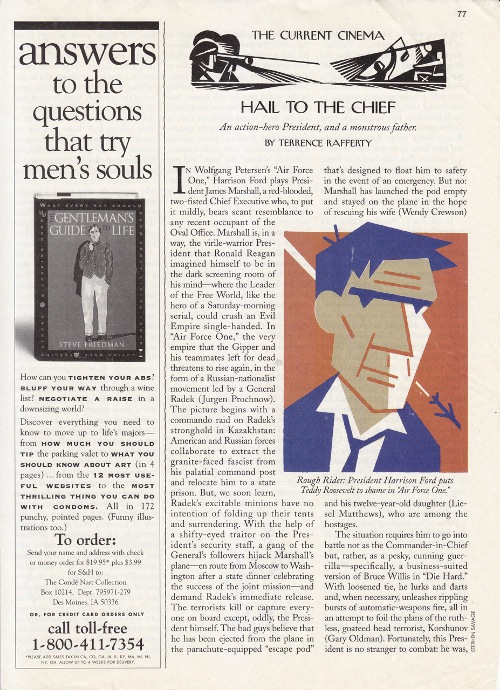
(in the action movie Air Force One), 1997
(Click to enlarge)
(Click to enlarge)

(Click to enlarge)

Jules: Where are your stompin’ grounds?
Stephen: I live in Park Slope, Brooklyn, with my wife Stefanie, our daughter Chloë, and our dog Trinka.

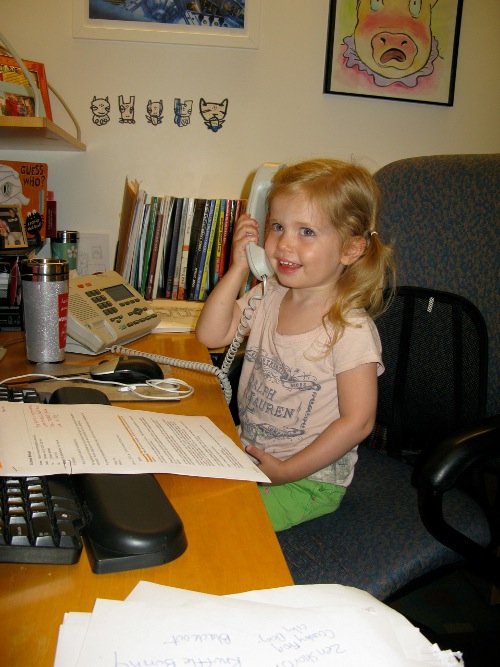



(Click to enlarge)
(Click to enlarge)
Jules: Can you briefly tell me about your road to publication?
Stephen: I was an art history major at the University of Wisconsin-Madison. After graduation, I moved to New York and worked in publishing for five years. During this time, I became interested in children’s books and published two pop-up books. By then, I was serious about becoming an illustrator, so I enrolled in the MFA Illustration program at the School of Visual Arts, graduated, and subsequently worked for many years as an editorial illustrator (still do).

He also edited/art-directed Polar Bear Night.”
In 1999, I began working with David Saylor and Lauren Thompson at Scholastic. Lauren wrote Polar Bear Night with me in mind as the illustrator, and David edited, art-directed, and designed the book. In 2004, it was named a New York Times Best Illustrated children’s book, an ALA Notable Book, and a Charlotte Zolotow Honor Book.

(Click to enlarge)
(Click to enlarge)
Polar Bear Night (Scholastic, 2004)
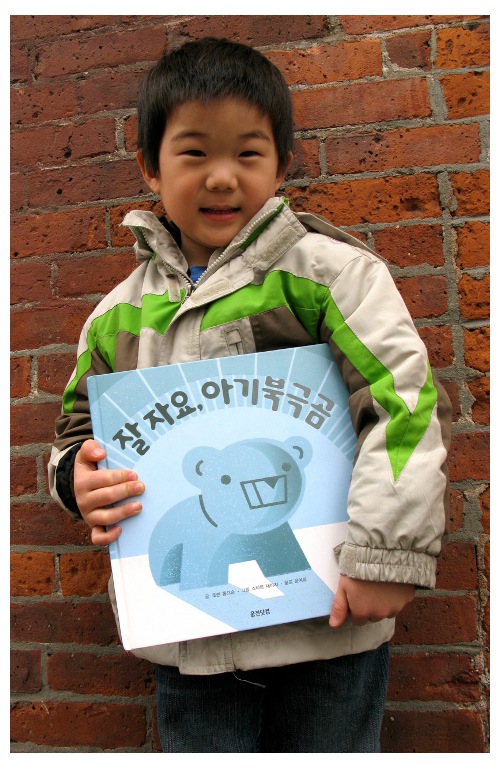
who is the son of illustrator Hyewon Yum,
a former student of mine at the School of Visual Arts.”
Jules: Can you please point readers to your web site and/or blog?
Stephen: www.stephensavage.net.

The Fathers Are Coming Home.
Here I am at Bookcourt in Brooklyn.”
“The pig father wallows over to his little piglets
that live in the pigpen and grunts at them.”
(Simon and Schuster/Margaret McElderry Books, 2010)
(Click to enlarge)
Jules: If you do school visits, tell me what they’re like.
Stephen: The key always is to involve your audience. (Who doesn’t like to do “the wave” at a sporting event?) Q&A sessions are great for 2nd and 3rd graders. Kindergartners love songs or chants.
The first time I presented my wordless book, Where’s Walrus?, I totally panicked, thinking the students would be bored out of their skulls. As it turns out, Walrus is the most fun of all of my books to present, because it’s all about the students. Without a text, I’m free to do whatever. I remember I stood up in front of 300 kids in a school auditorium outside of Chicago with a microphone strapped to my face and had the students “vogue” the various poses in the book. I was like an aerobics instructor.
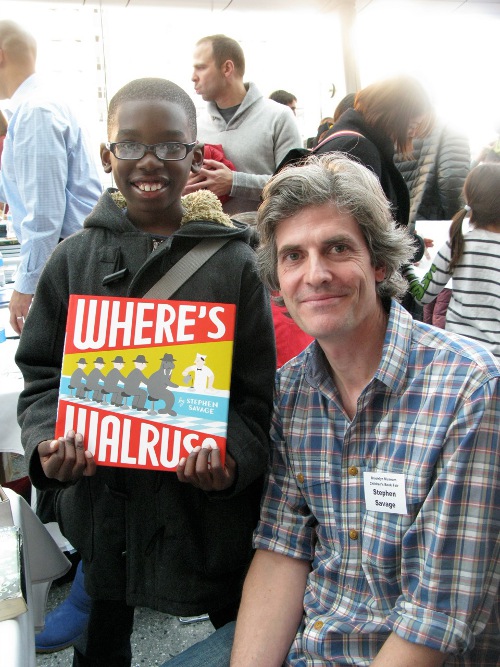

such as this one, which only recently established a library.”
7-Imp: If you teach illustration, tell me how that influences your work as an illustrator.
Stephen: I teach at the School of Visual Arts in Manhattan, which is great because it keeps me in “student mode.” I’ll hand out an assignment and tell students, “I want four thumbnails, two roughs, one color sketch. THEN you can do the final art.” Then, I’ll think to myself, “I’ve gotten lazy. I don’t even follow that regimen anymore.” Teaching forces you to “practice what you preach.”

Jules: Any new titles/projects you might be working on now that you can tell me about?
Stephen: Ten Orange Pumpkins for Dial Books will be out Fall 2013, and I am hard at work on a few other projects, one involving a (playful, plucky, lively) Walrus.
 Okay, the coffee’s on the table, and it’s time to get a bit more detailed with seven questions over breakfast. I thank Stephen again for visiting 7-Imp.
Okay, the coffee’s on the table, and it’s time to get a bit more detailed with seven questions over breakfast. I thank Stephen again for visiting 7-Imp.
1. Jules: What exactly is your process when you are illustrating a book? You can start wherever you’d like when answering: getting initial ideas, starting to illustrate, or even what it’s like under deadline, etc. Do you outline a great deal of the book before you illustrate or just let your muse lead you on and see where you end up?
Stephen: I’ve worked as JUST the illustrator on three books, and that process is pretty straight-forward. I read the text a bunch of times and begin doodling ideas, trying to establish a “look” for the book. I experiment with setting and “audition” three or four different characters for the lead roles! I make a few finished pieces of art, too, to give everybody a sense of what the book is going to look like. Then it’s 1) rough dummy 2) tight dummy and 3) final art.
(Click to enlarge)
The process of writing and illustrating is a lot more difficult in that you are both coming up with the problem and the solution simultaneously. You start with an idea and ask a “What if” question. For example, “What if a hat fell onto the head of walrus and everybody mistook him for a man.” Often times, story ideas don’t make it past this initial phase. But if they do, you’re ready to attempt a dummy.
(Click to enlarge)
(Click to enlarge)
A final spread from the book:
“The stars are like snowflakes, falling, falling.
They light up the snow and the ice.
They light up the lapping waves of the sea.
They light up the walrus and the seals and the whales.”
(Click to enlarge)
Here’s where you can tell if your book has “good bones” (a term Neal Porter taught me). You (and others) can have the experience of reading the book and taking delight in the movement of the story from beginning to end. Making a dummy can take years and countless drafts (as in the case of Walrus) or it can take weeks (Little Tug). And throughout this maddening process, you’re pulling your hair out wondering, “why isn’t this working? Does my idea suck? Or is the idea fine, but my solution sucks? Or does it all suck?”

2. Jules: Describe your studio or usual work space.
Stephen: I work in a room in a warehouse in Red Hook, Brooklyn. I’m on a floor with about a hundred other artists, mainly painters and sculptors. May I add that our building was spared by Hurricane Sandy.

(Click to enlarge)
3. Jules: As a book-lover, it interests me: What books or authors and/or illustrators influenced you as an early reader?
Stephen: My favorite picture book as a kid was The Whales Go By by Fred Phleger, illustrated by Paul Galdone. I also loved Dr. Seuss, Aliki, Beatrix Potter, and P.D. Eastman.

(Click to enlarge)
4. Jules: If you could have three (living) authors or illustrators—whom you have not yet met—over for coffee or a glass of rich, red wine, whom would you choose? (Some people cheat and list deceased authors/illustrators. I won’t tell.)
Stephen: I have admired the work of William Joyce and Donald Crews for years. The two are very different, but I really connect with both. I’m hoping to run into Patrick McDonnell soon. I’m a huge fan of Me…Jane.
Influential authors and illustrators for me: Leonard Wiesgard, Crockett Johnson, Feodor Rojankovsky, Lois Lenski, and Paul Galdone. Richard McGuire and Steven Guarnaccia were mentors of mine and have always been guiding lights.
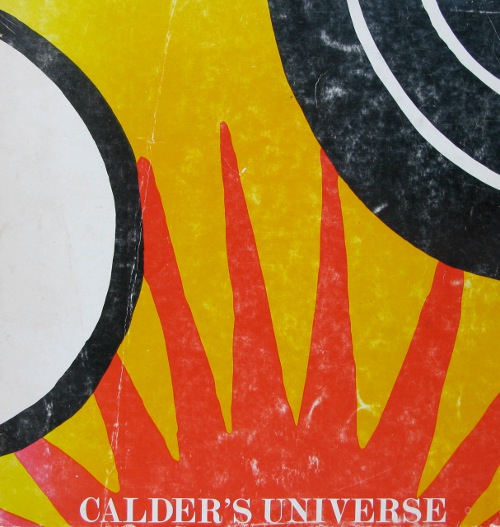

mid-century luggage labels.”
5. Jules: What is currently in rotation on your iPod or loaded in your CD player? Do you listen to music while you create books?
Stephen: I have the worst taste in music. It’s best described as “discarded pop tunes from the 1970s, often heard in the supermarket.” Artists like The Carpenters, Neil Sedaka, Boston, Captain & Tennille, England Dan & John Ford Coley … You get the idea. It’s the music I heard on the radio, growing up.
I also like public radio interview shows, like Fresh Air, Tell Me More, Bullseye, or local programs here in New York, like Leonard Lopate’s and Brian ehrer’s shows. Sometimes I’ll pop a film into the computer and listen to the director’s commentary. I’m a sucker for that process stuff.




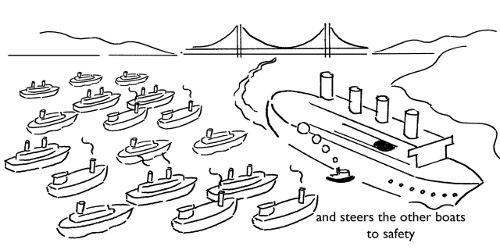


including a video (below) of early images

6. Jules: What’s one thing that most people don’t know about you?
Stephen: I’m messy and unorganized.
(Click to enlarge)
7. 7-Imp: Is there something you wish interviewers would ask you — but never do? Feel free to ask and respond here.
Stephen: Everybody always asks you about your strengths as an artist, but I’m constantly dwelling on my weaknesses. Which are: I’m terrible at drawing the figure (my drawing skills in general are “so-so”). And I’m really bad with complexity. It’s hard for me to juggle a lot of stuff in a picture.

Jules: What is your favorite word?
Stephen: The word “cool” is over-used but is just so direct and efficient — and works with everybody.
Jules: What is your least favorite word?
Stephen: “Ciao.”
Jules: What turns you on creatively, spiritually or emotionally?
Stephen: A good story.
Jules: What turns you off?
Stephen: When someone says to you, either through their actions or words, “I’m more important than you.”
7-Imp: What is your favorite curse word? (optional)
Stephen: “Bullsh–.”
Jules: What sound or noise do you love?
Stephen: Sorry to sound like every other parent out there, but I LOVE the sound of my daughter’s laughter. It makes me SOOOO happy.
Jules: What sound or noise do you hate?
Stephen: The sound of someone popping and cracking their gum on a New York City subway.
Jules: What profession other than your own would you like to attempt?
Stephen: Movie director.
Jules: What profession would you not like to do?
Stephen: Accountant.
Jules: If Heaven exists, what would you like to hear God say when you arrive at the Pearly Gates?
Stephen: “Relax, Steve. Breathe.”

POLAR BEAR MORNING. Copyright © 2013 by Lauren Thompson. Illustrations © 2013 by Stephen Savage. Published by Scholastic Press, New York. Spreads reproduced by permission of Stephen Savage.
LITTLE TUG. Copyright © 2012 by Stephen Savage. Published by Neal Porter/Roaring Brook, New York. Spreads reproduced by permission of Stephen Savage.
WHERE’S WALRUS? Copyright © 2011 by Stephen Savage. Published by Scholastic Press, New York. Spreads reproduced by permission of Stephen Savage.
POLAR BEAR NIGHT. Copyright © 2004 by Lauren Thompson. Illustrations © 2004 by Stephen Savage. Published by Scholastic Press, New York. Spreads reproduced by permission of Stephen Savage.
All other artwork and images used with permission of Stephen Savage.
The spiffy and slightly sinister gentleman introducing the Pivot Questionnaire is Alfred, © 2009 Matt Phelan.










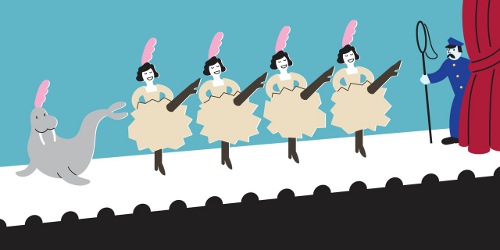










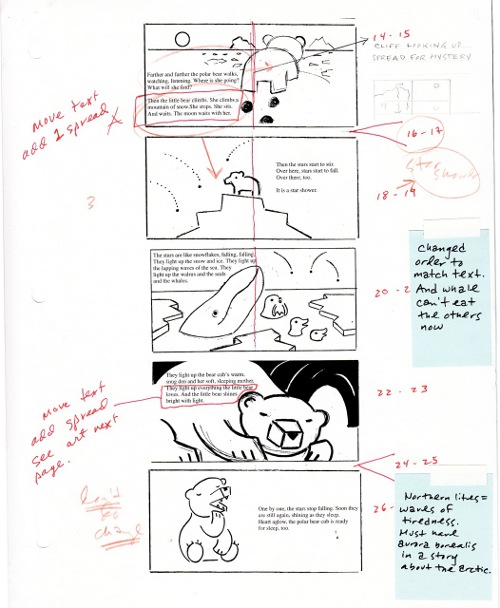
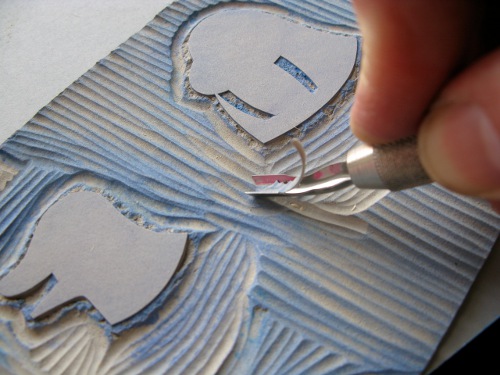






What a nice guy! What a fantastic illustrator!
This is amazing, Jules and Stephen. The visual display of his artistic process is terrific. I’m going to do a reread of Polar Bear Morning right now! Thanks.
What a great interview! Thanks Jules and Stephen!
Fun reading with my coffee breakfast. I like Stephen’s well thought out artwork, and he’s a nice guy — Thanks Jules and Stephen!
Great interview and beautiful artwork. I love seeing the early sketches and dummy pages.
Thumbs up! Great interview, and I love seeing all the artwork and photos, recent and not-so-recent. (Thanks, Stephen, for being such a great co-creator!) — Lauren T
How generous! Thank you. The video’s a hoot!
Jules – the video is PRICELESS! I love his art and Where’s Walrus is a favorite of mine from last year. Great interview – what a fun person he is. I really enjoy getting a glimpse into the real person behind the art. Thank you!
[…] 2015); Doreen Cronin’s Smick!, illustrated by Juana Medina (Viking, February 2015); and Stephen Savage’s Supertruck (Neal Porter/Roaring Brook, January […]
[…] picture books that feature the happy return of some beloved picture book protagonists, including Stephen Savage’s Where’s Walrus? And Penguin? (Scholastic, August 2015); Atinuke’s Double Trouble for […]
[…] here about James Kwan’s How It Feels to Be a Boat (Houghton Mifflin Harcourt, July 2017); Stephen Savage’s Little Plane Learns to Write (Neal Porter/Roaring Brook, June 2017); and Anjum Rana’s This […]